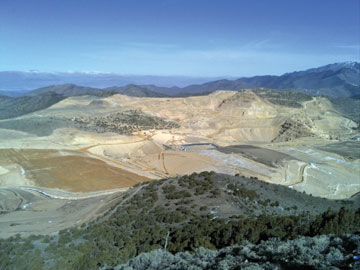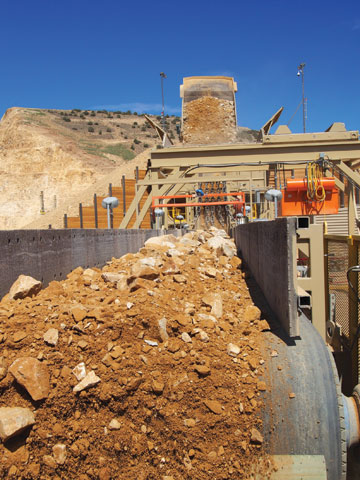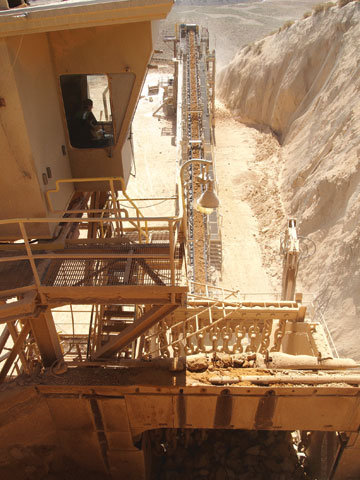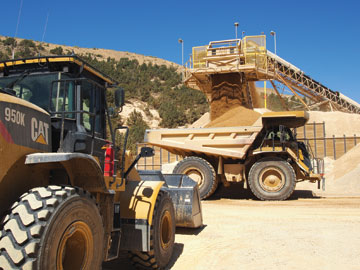By Russell A. Carter, Managing Editor
A U.S. silver mine processes valuable leftovers from its 27 years of operation to boost productivity—and profitability
It’s been a busy year for Coeur Mining’s Rochester operation. The long-running silver/gold surface mine, located near the town of Lovelock in western Nevada, has begun exploiting a new source of mineral revenue for its Chicago-based parent company. And, a recent announcement that its proven and probable silver reserves increased more than 91% this year—along with an 96.4% increase in gold reserves—offers increased clarity about its role in Coeur’s future plans.
Rochester is Coeur’s oldest mine and was once the company’s largest producer—but the Palmarejo underground/open-pit operation in Mexico now holds that distinction. However, Coeur Mining Inc. President and CEO Mitchell J. Krebs believes that Rochester has the potential to become one of the company’s largest cash-flow generators in the next five years, and Coeur has indicated that later this year it plans to release an announcement related to further expansion at the mine.
 Although reserves are sufficient to keep its in-pit production going for many more years, Coeur Mining’s Rochester silver mine also has begun processing an estimated 150 million tons of waste material that contains valuable silver content. (Photo courtesy of Battle Born Engineering)
Although reserves are sufficient to keep its in-pit production going for many more years, Coeur Mining’s Rochester silver mine also has begun processing an estimated 150 million tons of waste material that contains valuable silver content. (Photo courtesy of Battle Born Engineering)
It’s a very different picture from the darker days of January 2008, when Coeur—then known as Coeur d’Alene Mines Corp., based in its namesake northern Idaho city—announced that it was looking at “strategic alternatives” for Rochester. But the company reconsidered five months later and retained ownership of the mine, which at the time had measured and indicated mineral resources of more than 27.8 million oz of silver and 180,000 oz of gold.
In contrast, Coeur just reported that as of mid-September, the Rochester property contains approximately 69.3 million silver oz and 560,000 gold oz contained in measured and indicated resources, and about 26.2 million silver oz and 105,000 gold oz from inferred resources.
Those recent figures, according to the company, don’t reflect the results of its 2013 drilling at Rochester, an ongoing program that has been under way since 2012 to delineate the characteristics of its newest source of mineralization—the huge piles of mining waste, sometimes called non-ore rock, that have accumulated since the mine began operating in 1986.
The stockpiles, covering about 40 acres, are expected to play a steadily increasing role in Rochester’s future production plans, according to Coeur Rochester General Manager Robert Stepper. “The mine opened in 1986 and the first (Stage I) pad was completely full by about 1991. At the time, it was loaded with ore grading about 2.5 oz per ton silver, with a 1.5 oz per ton cutoff,” he explained. Anything below that cutoff went to the waste stockpiles.
“Although there is some true waste in the waste stockpiles from those years, there’s also plenty of material that averages between 0.8 and 0.87 oz per ton. We’re very interested in that,” he said.
Over the next few years, Rochester will focus on three major stockpiles that comprise about 100 million tons of material in total; most of this material has been drilled and assayed under the current program, but as much as 50 million more tons remain in two other stockpiles, and the company expects that drilling results from this additional material will allow Rochester to expand its reserve base even further. As with the previously drilled stockpile material, the remainder will be drilled using reverse-circulation rigs, on 50-ft (15-m) centers.
Coeur just completed a $5 million upgrade to the mine’s primary crusher and plans to spend another $22.5 million to expand Rochester’s heap leach capacity. Recent modifications to its Merrill-Crowe plant have doubled that facility’s processing capacity, and a cost-cutting program involving a number of areas, ranging from lower reagent and power consumption to shortened haul distances, represent ongoing efforts to control the mine’s operating costs.
Quite possibly the most formidable obstacle standing in the way of its future success was removed in late June when Coeur announced it had reached an out-of-court settlement with Rye Patch Gold U.S. Inc., a Vancouver, B.C.-based exploration company, ending a dispute over ownership of mining claims covering 7,500 acres that impinged upon Rochester’s active mining areas. The settlement called for Coeur to pay Rye Patch Gold $10 million in cash plus a 3.4% net smelter royalty covering 39.4 million silver equivalent oz of net metal sales. In exchange, Rye Patch transferred the mining claims involved in the dispute to Coeur Rochester Inc., the wholly-owned subsidiary of Coeur.
Success, by Stages
Rochester’s first leach pad—the Stage I pad—was decommissioned and reclaimed about 20 years ago. In the years since, active leaching shifted to the mine’s Stage II pad, located to the south of Stage I; and the Stage IV pad, located to the north of Stage I and the mine’s processing plant. Construction on the Stage III pad began in 2011.

 A recently completed $5 million project to upgrade Rochester’s primary crushing capacity includes a new dump station, feeder and 96-in.-wide belt. The new belt section is equipped with a metal detector and powerful electromagnet to protect the mine’s jaw crusher (right) from tramp metal contained in the waste material.
A recently completed $5 million project to upgrade Rochester’s primary crushing capacity includes a new dump station, feeder and 96-in.-wide belt. The new belt section is equipped with a metal detector and powerful electromagnet to protect the mine’s jaw crusher (right) from tramp metal contained in the waste material.
At the time of E&MJ’s visit, Stage III had been loaded with about 25 million tons of material, but work was under way on a project to expand the pad’s capacity by raising its permitted height, making room for about 40 million more tons of ore. In connection with this, contractors are building an earthwork buttress against the southeast pit wall to provide a secure corridor from the ore crushing facility to the Stage III pad and the process plant. The mine’s medium-term plans include an additional pad (Stage V), which, pending approval by regulators, would add another 50 million tons of leach capacity.
Stepper explained that extraction of the valuable waste material also will make room for disposal of “true” waste [based on today’s metal prices] from ongoing mining operations in the pit—because even with the increased attention to the waste stockpiles, mining is expected to continue in Rochester’s main pit for many years to come.
“We still have plenty of reserves in the pit—150 million tons, with an additional 270 million tons of resources including the stockpiles, and we’re always expanding the pit limits, Stepper said. Currently, we’re mining the north setback in the pit and have a good grade of ore there, about 1.1 oz silver equivalent.”
Mining at Rochester is a conventional drill / blast / truck haul operation, employing Caterpillar 993K and 992 wheel loaders and a fleet of Cat 777F haul trucks, moving about 50,000 tons of material per day, almost all of it ore.
“We’re one of the few mines that crushes all the ore to minus 3/8 in. before loading it on the pad,” Stepper said. “Over the years, a lot of research has been carried out to see if we could raise the crush size, but we’ve found that our maximum recovery rate—61% for silver and 92%–96% for gold—is tied very closely to that size.”
In 2003, the mine’s original four-stage crushing setup was replaced with a tertiary system employing 7-ft standard cone crushers for secondary reduction, and dual 8-ft long head cone crushers for tertiary crushing. Oversize from the secondary crushing stage is separated from the product feed at a scalping screen station and sent to the tertiary crushers for further reduction. The final, minus 3/8-in. material reports to a loadout that automatically fills the three Cat 777F haulers assigned to leach pad duty. The pads are loaded in 30-ft (9-m) lifts, separated by 30-ft benches per lift.
“A unique feature at Rochester is the consistency of the ore,” he added. “From year to year, from one mining area to another, and even between ore from the pit or the waste stockpiles, ore grade and recovery rates have been extremely constant. We have a really nice oxide orebody here—when we see ‘high’ sulphide levels in the Rochester ore, we’re only talking about 0.5%.”
That doesn’t mean that recent mining at Rochester has been completely without problems, though. As Coeur Mining noted in its 2013 second-quarter report, even though Rochester produced 843,845 oz of silver and 9,404 oz of gold during the quarter—up 30% and 8%, respectively, over the first quarter 2013—it was less than expected. The makeup of the waste stockpiles contributed to that shortfall.
“Mining the waste involved a bit of a learning curve,” Stepper said. “The stockpiles are often stratified, with fines in one layer and large, broken material in the next. Moisture has accumulated internally over the years, but we still encounter dry pockets. We had to figure out how to dry and blend this material to get the best crushing and recovery results.”
The long-term production plan for the stockpiles is based on having roughly 50,000 tons of material ready at all times—after being bulldozed, blended and dried—for haulage to the crusher. The proximity of the stockpiles to the active mining areas in the pit allow the mine to more or less seamlessly extend its standard bench and road configuration into the waste areas, allowing efficient extraction of material that can then be processed minus the economic burden of drilling and blasting costs.
It’s a prospect that has Coeur executives optimistic about the future of the mine. As Mitchell Krebs said on a conference call during a Barclays Capital investment forum earlier this year, “At prices in the 20s, actually anywhere really above 12 or 13 dollars an ounce for silver, those waste dumps become economic to reprocess…it’s great business because it’s already been mined, it’s already sitting on the surface; we just need to reprocess it and get it on the leach pads. And that will produce a lot of silver and gold over a lot of years.”
Recent investments in Rochester’s existing heap leach pads at Rochester have increased total leach capacity by 72 million tons, which Coeur expects will enable operations to continue into the second half of 2017. In addition, Coeur’s announced plans for Rochester include:
• An anticipated increase in annual crush ing rates by approximately 18.5 million tons beyond 2017.
• A program to obtain permits for 120 million tons of additional pad capacity, which are expected to be received by mid-2016. This expanded capacity is predicted to further extend Rochester’s mine life, based on existing reserves, through at least 2023.
• Ongoing assessment of an optimal scenario for a further expansion of Rochester, targeting opportunities to expand reserves from both stockpiles and in situ targets.
Higher Throughput, Lower Costs
A critical element of Rochester’s enhanced processing capacity is its recently upgraded primary crusher facility, which raised the mine’s crushing throughput to 2,200 t/h in order to handle the higher volume of material arriving from the stockpiles. The project involved installation of a new 300-ton-capacity dump hopper, vibrating feeder and 96-in. wide conveyor belt that transports dumped material from the hopper, through a tramp-metal detection and removal system, and on to the crusher feed point. The system includes a metal detector and a suspended, 26,000-lb (11,800-kg) Eriez electromagnet that snatches metal items off the belt. It’s set up to process rock fragments up to 48 in. (122 cm) in diameter, the largest the mine’s 48-in. by 60-in. Pennsylvania Crusher jaw crusher will accept. The feed components of the system are sized to handle up to 3,500 t/h, allowing plenty of room for future capacity increases if necessary.
 An automated loadout fills a Cat 777 in seconds with crushed material bound for leach pad placement.
An automated loadout fills a Cat 777 in seconds with crushed material bound for leach pad placement.
“This is one of the largest metal removal systems I’ve ever seen,” said Stepper, who is a metallurgist by training, “and we couldn’t run the stockpile material without it. The tramp metal can damage the jaw crusher, and there’s a lot of it in the waste material,” Stepper said, pointing to a nearby pile of iron and steel junk that the system had recovered just in the few weeks between its July 8 startup and E&MJ’s visit in August. In addition to the more modern types of tramp metal objects found in waste material, historic mining activities around the site also left their own variety of buried junk behind, according to Stepper. Prior to installation of the metal detection and removal equipment, Rochester had, in recent years, experienced a couple of metal-related crusher downtime incidents that, in total, cost the company millions in costs and lost revenue. Ironically, the items that damaged the crusher in both instances were metal crusher parts left from earlier operations.
The valley-fill layout of the mine’s leach facilities enables it to use a counter-current fluid management system to circulate and store process solution within the pads, eliminating the need for large process solution ponds. However, until recently, the Merrill-Crowe plant could only process about 6,000 gal per minute (22,700 l/min), meaning that roughly 4,000 gal per minute had to be recirculated through the heaps.
“That solution carried value—substantial value,” Stepper said. In 2011, the mine added a second filtration unit to the plant, and in June, completed installation of a second de-aeration tower. The result: “Now we can process up to 12,000 gal per minute and take full advantage of every drop of solution.”
The mine has also improved process efficiency, and found a way to substantially cut its energy costs, by installing variable frequency drives on many of its main pumps. “Instead of the old approach, where we would keep the pumps running at full bore and control the flow by adjusting the valves, we now can run the pump motors at the specific speed necessary to optimize flow,” said Stepper. “By doing this we were able to cut electrical consumption by 30% across the property, and received a sizable rebate check from the utility company as a result.”






